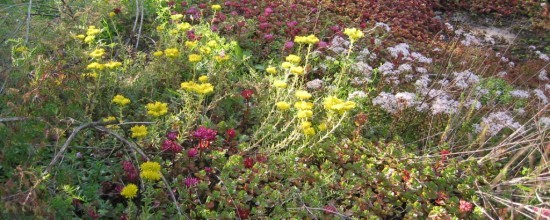
Vegetation research

When planting the green roofs, great care was taken to ensure a varying mix of colorful, blooming plants, like Onobrychis, Anthyllis and different sedum-species. During the first years, the ufaFabrik gardeners watered the plants regularly, which had a positive effect on the different types of clover and other sensitive species. But since all rainwater is collected and used to flush the toilets now, the roofs are rarely watered. The vegetation has adapted to the decreased water supplies, which has led to the thriving of the already well established sedum-species – they cover around 50% of most roofs now. Sedum-species are typical for these kinds of locations, since they are suited for dry weather conditions. But there are also numerous plants from the days of regular watering that have survived as seeds in the soil and flourish in especially rainy years, such as 2004. This not only leads to a different vegetation every year, it also contributes to urban biodiversity – an effect that has been observed with interest by our English colleagues. 40-50 different plants grow on every roof, which is a significantly larger number than on most other green roofs in Berlin.
Not all conditions are the same on every roof. The theater roof receives the most direct sunlight. As a result, the sedum-species are the most prominent plants here. The photovoltaics-system on the roof of the school building next to it functions as a large screen that shields the roof from direct sunlight, as well as the wind. As a result, the plants on this roof grow taller, examples are the Artemisia vulgaris and Berteroa incana. The roofs of lower buildings, like the Café Olé and the exhibition venue are surrounded by tall trees that provide the edges of the roofs with shade, which is unusual for green roofs. With this protection, the plants that grow here are grasses and various types of Geraniums and Vicia which favor the shade.
On the roof of the Ökoausstellung, which was planted in 1994, the substrate is thinner; it only consists of a few centimeters of soil. Various sedum-species were planted here as a test, but many flourished: not only the usual types like Sedum album (with white flowers) or Sedum sexangulare (with yellow flowers), but also Sedum spurium (Caucasian stonecrop) and Sedum ewersii (with grey leaves) grow here, creating a vast diversity.
Research Project Fachhochschule Neubrandenburg:
This research project is led by Manfred Köhler. Köhler received his doctorate in 1987 for his research about the “Ecological effects of green façades” („Die ökologischen Wirkungen von Fassadenbegrünungen“) at the Technische Universität Berlin. He has been leading researches on green roofs as well: “The possibilities of using vegetation to create a livable city are far from being exhausted – this is slowly being recognized by an increasing number of architects. Providing arguments for this case is one of the tasks of case studies and applied ecological research”
The ufaFabrik’s green roofs are very suitable case studies. They were planted in the mid-eighties and since 1992, Köhler has regularly studied the biodiversity of their vegetation.
Köhler is amongst the few researchers who have academically studied green roofs for an extensive period of time. As a professor at the Fachhochschule Neubrandenburg since 1994, he has had the opportunity to execute researches that focus on the long term.
